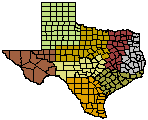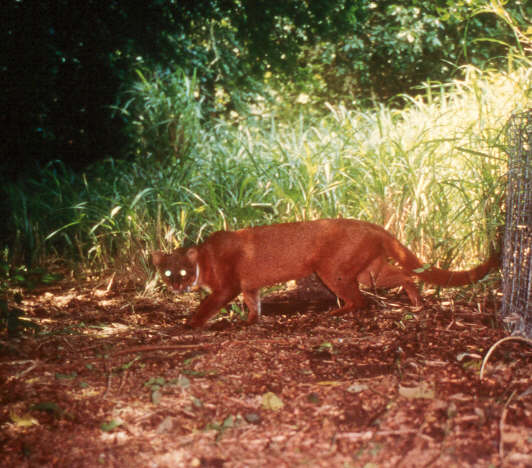- Trans Pecos
- High Plains/Panhandle
- Cross Timbers
- Hill Country
- Post Oak Savannah
- Pineywoods
- Oak Prairie
- South Texas Plains

Wildlife Division District Map
South Texas Wildlife Management
Endangered Species
 The
South Texas Brushlands are better known for its large ranches and deer,
but it also supports a very diverse assemblage of habitats supporting many
nongame species. The high number of unique species occurring within the
region are in part due to the southern location of the region being quite
different than the rest of Texas, but also to the unique habitats like
Tamaulipan floodplain forest which reach the limits of their range in southern
Texas. Among nongame species in South Texas using this diverse assemblage
of habitats there are a number of federally listed threatened and endangered
species which include: mammals such as ocelots and jaguarundis, and ; birds
like brown pelican, whooping crane, bald eagle, northern aplomado falcon,
piping plover, least tern (inland breeding populations); plants such as
black lace cactus, star cactus, Walker's manioc, Johnston's frankenia,
Texas ayenia, South Texas ambrosia, ashy dogweed, slender rush-pea. Other
federally listed species occur in some of the habitats at the edge of the
South Texas Brushland ecosystem are not in this report and can be found
in the Texas Parks and Wildlife Department Nature/Endangered Resources
web pages.
The
South Texas Brushlands are better known for its large ranches and deer,
but it also supports a very diverse assemblage of habitats supporting many
nongame species. The high number of unique species occurring within the
region are in part due to the southern location of the region being quite
different than the rest of Texas, but also to the unique habitats like
Tamaulipan floodplain forest which reach the limits of their range in southern
Texas. Among nongame species in South Texas using this diverse assemblage
of habitats there are a number of federally listed threatened and endangered
species which include: mammals such as ocelots and jaguarundis, and ; birds
like brown pelican, whooping crane, bald eagle, northern aplomado falcon,
piping plover, least tern (inland breeding populations); plants such as
black lace cactus, star cactus, Walker's manioc, Johnston's frankenia,
Texas ayenia, South Texas ambrosia, ashy dogweed, slender rush-pea. Other
federally listed species occur in some of the habitats at the edge of the
South Texas Brushland ecosystem are not in this report and can be found
in the Texas Parks and Wildlife Department Nature/Endangered Resources
web pages.
Habitats in the region range from classic hill country cedar brakes, riparian woodlands and grasslands at the edge of the northwestern counties. Remnant tracts of coastal prairie occur in the east. Oak-prairie dominates northeastern counties, and liveoak mottes associated with grasslands do the same in Brooks, Kenedy & Kleberg Counties. Mixed brush grasslands dominated by mesquite occur throughout most of the ranchland. Tamaulipan scrub forest grow along the Rio Grande River, and major areas of intense agriculture are managed in the Lower Rio Grande Valley, near Corpus Christi and Uvalde. Ash/elm/hackberry forests occur along the few creeks and rivers along with some pecan groves along the San Antonio River. Beaches and hyper-saline lagunas dominate the edge of the Gulf of Mexico.
Loss of native habitat and reduction in quality of the remaining plant communities is the primary reason for declining populations of most species: game, nongame, and federally listed threatened and endangered. Natural occurring fire as an ecological force which formally helped mold the native grassland and brushland habitats has essentially disappeared with only a few landowners currently using it as a management tool. Agriculture and urban sprawl has occupied large areas of some of the most productive habitats in the region. Use of heavy machinery (root plowing, cabling, chaining, roller chopping, and rome disking to reduce brush for livestock grazing and subsequent seeding of the range with introduced grasses, like bufflegrass, has greatly modified the plant species composition of native habitats and reduced the quality of the land for wildlife.
The classic endangered mammal of the South Texas Brush Country that has been greatly impacted by brushland management is the ocelot. This species is a rare, colorful, spotted cat that once occurred throughout South Texas, the southern Edwards Plateau Region, and along the Coastal Plain, but now is restricted to the southernmost 13 counties of the state because of loss of habitat. This species occurs in dense thorny shrublands of the Lower Rio Grande Valley and Rio Grande Plains. Typical habitat consists of mixed brush species with an interspersion of trees. Optimal habitat has at least 95 percent canopy cover of shrubs, whereas marginal habitat has 75 to 95 percent canopy cover. Preferred shrub density is where depth of vision from outside the brush line is restricted to about five feet. Tracts of at least 100 acres of isolated dense brush, or 75 acres of brush interconnected with other habitat tracts by brush corridors, are considered very important. These habitat settings are very rare in the region and is the main reason for low numbers of this species.
An endangered bird which depends heavily on South Texas beaches and lagunas for its survival is the Piping Plover. This species is a small, stocky, sand-colored plover with orange legs that occupies Texas beaches, bays and lagoons during the non-breeding season which runs from July through May. The birds spends most of its time foraging and resting on mudflats, sandflats or algal flats in the back bays and retreats to the beaches during high tides. Major threats to the species in Texas are disturbance and development along the beaches as well as chemical spills from the petroleum industry within the bay/laguna systems and the Gulf of Mexico.